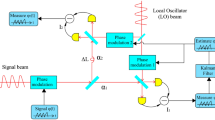Abstract
The interference method for determining the velocity of objects using direct optical heterodyning (photonic Doppler velocimetry) has become widespread due to the ease of setting up the fiber-optic system, the unambiguous results that it produces, and the wide possibilities for varying the measurement accuracy and temporal resolution. The accuracy of velocity measurements can be fractions of a percent, but there are a number of factors that interfere with this. For example, a change in the velocity of an object, that is, its movement with acceleration, leads to a broadening of the signal spectrum with an increase in the working time window and, as a result, to a decrease, rather than an increase, in the accuracy of measuring the velocity. In this letter, a method is proposed that allows one to compensate for the effect of acceleration on the accuracy of velocity measurement. The proposed model for processing the registered signals makes it possible to determine both the acceleration and the velocity of the object. The applied algorithm made it possible to avoid the expansion of the spectrum with an increase in the time window and to improve the accuracy of measuring the velocity of a freely falling body by an order of magnitude.



Similar content being viewed by others
REFERENCES
O. T. Strand et al., Proc. SPIE 5580 (2004). https://doi.org/10.1117/12.567579
D. H. Dolan, Rev. Sci. Instrum. 91, 051501 (2020). https://doi.org/10.1063/5.0004363
V. V. Svetozarov, Fundamentals of Statistical Processing of Measurement Results (MIFI, Moscow, 2005) [in Russian].
P. Younk and B. Medina, AIP Conf. Proc. 1793, 160013 (2017). https://doi.org/10.1063/1.4971753
M. Montgomery and D. O’Donoghue, Delta Scuti Star Newslett. 13, 28 (1999).
D. H. Dolan, Rev. Sci. Instrum. 81, 053905 (2010). https://doi.org/10.1063/1.3429257
T. V. Kazieva, A. P. Kuznetsov, K. L. Gubskii, M. V. Po-narina, and V. N. Reshetov, Tech. Phys. Lett. 43, 148 (2017). https://doi.org/10.1134/S1063785017020055
D. H. Dolan and S. C. Jones, Rev. Sci. Instrum. 78, 076102 (2007). https://doi.org/10.1063/1.2754405
M. Gorbashova et al., J. Phys.: Conf. Ser. 941, 012002 (2017). https://doi.org/10.1088/1742-6596/941/1/012002
Funding
This work was supported financially by the Ministry of Science and Higher Education of the Russian Federation, agreement with the Joint Institute for High Temperatures of the Russian Academy of Sciences no. 075-15-2020-785.
Author information
Authors and Affiliations
Corresponding author
Ethics declarations
The authors declare that they have no conflicts of interest.
Rights and permissions
About this article
Cite this article
Kazieva, T.V., Tishchenko, I.Y., Reshetov, V.N. et al. A Three-Phase PDV Signal-Processing Method that Eliminates the Influence of Acceleration on Determining Velocity. Tech. Phys. Lett. 48, 66–69 (2022). https://doi.org/10.1134/S106378502203004X
Received:
Revised:
Accepted:
Published:
Issue Date:
DOI: https://doi.org/10.1134/S106378502203004X



